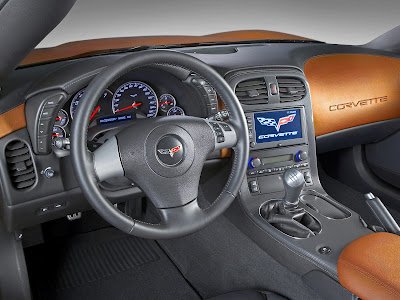The 2LT gains a head-up display, Bluetooth, a touchscreen navigation system, an iPod/USB audio interface and a nine-speaker Bose sound system. The 3LT adds a power telescoping steering wheel (manual tilt), driver memory functions and heated six-way power sport seats (manual recline) with power-adjustable bolsters and lumbar. The Convertible 3LT also gets a power-folding soft top. The 4LT gets extended leather interior trim, faux-suede seat inserts and extra armrest padding.
The Grand Sport is also available in the above trims, but adds to each stiffer springs and stabilizer bars, different dampers, larger and cross-drilled brakes, special wheels and Grand Sport styling elements. When equipped with the standard manual transmission, it also features a dry-sump oil system and a differential cooler.
Options on the base Vette and GS include an adaptive suspension, a transparent removable roof panel, dual-mode exhaust (adds 6 extra horsepower) and a convertible wind deflector. The Chevrolet Centennial Special Edition available on the 3LT or 4LT trims of both the base Vette and GS adds unique black paint, black and red wheels, and the adaptive suspension.
The Z06 is available in 1LZ, 2LZ and 3LZ sub-trims. Each one gets a bigger V8 engine, essentially the same suspension and brake setup as the Grand Sport, axle and transmission coolers, unique wheels, carbon-fiber front fenders and floor panels, and a head-up display. In terms of comfort and convenience equipment, the Z06′s sub-trims are pretty much identical to their “LT” counterparts except that the 3LZ gets the 4LT’s extra leather interior bits. The Carbon Fiber package adds most of the ZR1′s carbon-fiber body pieces for reduced weight along with a ZR1-style spoiler. The Z06 Ultimate Performance package adds carbon-ceramic brakes, lightweight black wheels (19 inches front and 20 inches rear), Michelin Pilot Sport Cup run-flat tires, an adaptive suspension, Performance Traction Management and a larger spoiler.
Safety
Antilock disc brakes and side airbags are standard. Side curtain airbags are not available.
The 2012 Chevrolet Corvette’s special “Active Handling” stability control system has been tuned to engage in a soft, noninvasive way that doesn’t panic you. The Corvette’s stability control also includes a Competition mode that gives the expert driver more leeway for aggressive dynamics while still maintaining an effective safety net. The even more sophisticated Performance Traction Management system is standard on the ZR1 and optional on the Z06.
In Edmunds brake testing, a base Corvette came to a stop from 60 mph in 118 feet, which is decent for a sports car. We found that the Grand Sport and ZR1 came to a stop from 60 mph in between 100 and 104 feet, which is excellent performance. However, a Z06 Carbon did it in an astonishing 96 feet, one of the best numbers we’ve ever recorded.
Interior Design and Special Features
The Corvette’s interior is certainly functional, and Chevrolet has been offering upgraded interior appointments for a few years now, yet the overall interior quality still leaves a lot to be desired. Step out of a BMW M3 or a Nissan GT-R and into a ‘Vette and you’ll likely find the Chevy’s trim pieces, controls and overall ambience disappointing. While the affordable price of a base Corvette seems to excuse such things, the costlier Z06 and ZR1 play in a more demanding market. The front seats and their bolsters have been enhanced for 2012; they may finally lose their standing as the worst seats found in a sports car. On the bright side, the Vette’s large gauges and remarkable cargo capacity (22 cubic feet in coupes and 11 cubes in the convertible) make it a sports car that’s easy to live with on a day-to-day basis.
Driving Impressions
No question here: The 2012 Chevrolet Corvette can bring the heat. The base car is extremely fast: the Z06, terrifyingly so. As for the ZR1, any car whose speed at the end of the quarter-mile approaches 130 mph is just in a different league — the ballyhooed Nissan GT-R trails the ZR1 by a full 10 mph here. Top to bottom, the Corvette stable has enough broad-shouldered eight-cylinder force to satisfy even the most depraved speed fiend. Nor does this hamper drivability, as all Corvette models are pretty easy and comfortable to drive around town.
Compared to a car like the M3, the Corvette’s steering can indeed seem a bit deficient in terms of communication. Thanks to their upgraded suspensions and tires, though, the ZR1 and Z06 (with the Ultimate Performance package) are noticeably better in this regard. The Vette’s brakes are strong and fade-free, especially the available carbon-ceramic binders, and grip from the enormous tires is, well, enormous. However, the Chevy Corvette still feels less nimble than it should when driven on tight, curvy roads.
All models of the 2012 Corvette receive new seats and a redesigned steering wheel. The seats are distinguished by their wings and thigh support more pronounced for better support, especially during high-speed maneuvers, while remaining comfortable for everyday driving in the city. The microfiber suede inserts available as an option to improve the tactile sensation and a supporter.
The new seats are complemented by the redesigned steering wheel adorned with badges of the model, a control key pad purest ray and packed. The center console and armrests are padded in all 2012 models. We note another key aesthetic edge: the stitching in a contrasting color – red, blue and yellow – which accompany the custom leather coatings.
Also new in 2012, the new sound system Bose premium includes nine speakers (compared to seven in 2011) to offer a more finely optimized audio reproduction with respect to acoustic properties of the cabin. The new speakers beginning of the dashboard and the system of new generation Nd serious are the main advantages that the driver of the Corvette can detect ear.















